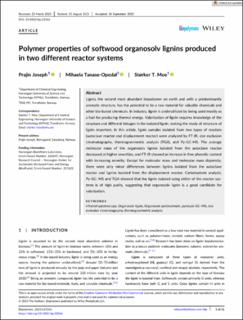| dc.contributor.author | Joseph, Prajin | |
| dc.contributor.author | Tanase-Opedal, Mihaela | |
| dc.contributor.author | Moe, Størker T. | |
| dc.date.accessioned | 2023-12-11T10:19:20Z | |
| dc.date.available | 2023-12-11T10:19:20Z | |
| dc.date.created | 2023-09-18T09:33:05Z | |
| dc.date.issued | 2023 | |
| dc.identifier.issn | 0006-3525 | |
| dc.identifier.uri | https://hdl.handle.net/11250/3106815 | |
| dc.description.abstract | Lignin, the second most abundant biopolymer on earth and with a predominantly aromatic structure, has the potential to be a raw material for valuable chemicals and other bio-based chemicals. In industry, lignin is underutilized by being used mostly as a fuel for producing thermal energy. Valorization of lignin requires knowledge of the structure and different linkages in the isolated lignin, making the study of structure of lignin important. In this article, lignin samples isolated from two types of reactors (autoclave reactor and displacement reactor) were analyzed by FT-IR, size exclusion chromatography, thermogravimetric analysis (TGA), and Py-GC-MS. The average molecular mass of the organosolv lignins isolated from the autoclave reactor decreased at higher severities, and FT-IR showed an increase in free phenolic content with increasing severity. Except for molecular mass and molecular mass dispersity, there were only minor differences between lignins isolated from the autoclave reactor and lignins isolated from the displacement reactor. Carbohydrate analysis, Py-GC–MS and TGA showed that the lignin isolated using either of the reactor systems is of high purity, suggesting that organosolv lignin is a good candidate for valorization. | en_US |
| dc.language.iso | eng | en_US |
| dc.publisher | Wiley Periodicals LLC. | en_US |
| dc.rights | Navngivelse-Ikkekommersiell 4.0 Internasjonal | * |
| dc.rights.uri | http://creativecommons.org/licenses/by-nc/4.0/deed.no | * |
| dc.title | Polymer properties of softwood organosolv lignins produced in two different reactor systems | en_US |
| dc.title.alternative | Polymer properties of softwood organosolv lignins produced in two different reactor systems | en_US |
| dc.type | Peer reviewed | en_US |
| dc.type | Journal article | en_US |
| dc.description.version | publishedVersion | en_US |
| dc.source.volume | 114 | en_US |
| dc.source.journal | Biopolymers | en_US |
| dc.source.issue | 12 | en_US |
| dc.identifier.doi | 10.1002/bip.23566 | |
| dc.identifier.cristin | 2175895 | |
| dc.relation.project | Norges forskningsråd: 226247 | en_US |
| dc.relation.project | Norges forskningsråd: 257622 | en_US |
| dc.relation.project | Norges teknisk-naturvitenskapelige universitet: 70441799 | en_US |
| cristin.ispublished | true | |
| cristin.fulltext | original | |
| cristin.qualitycode | 1 | |

